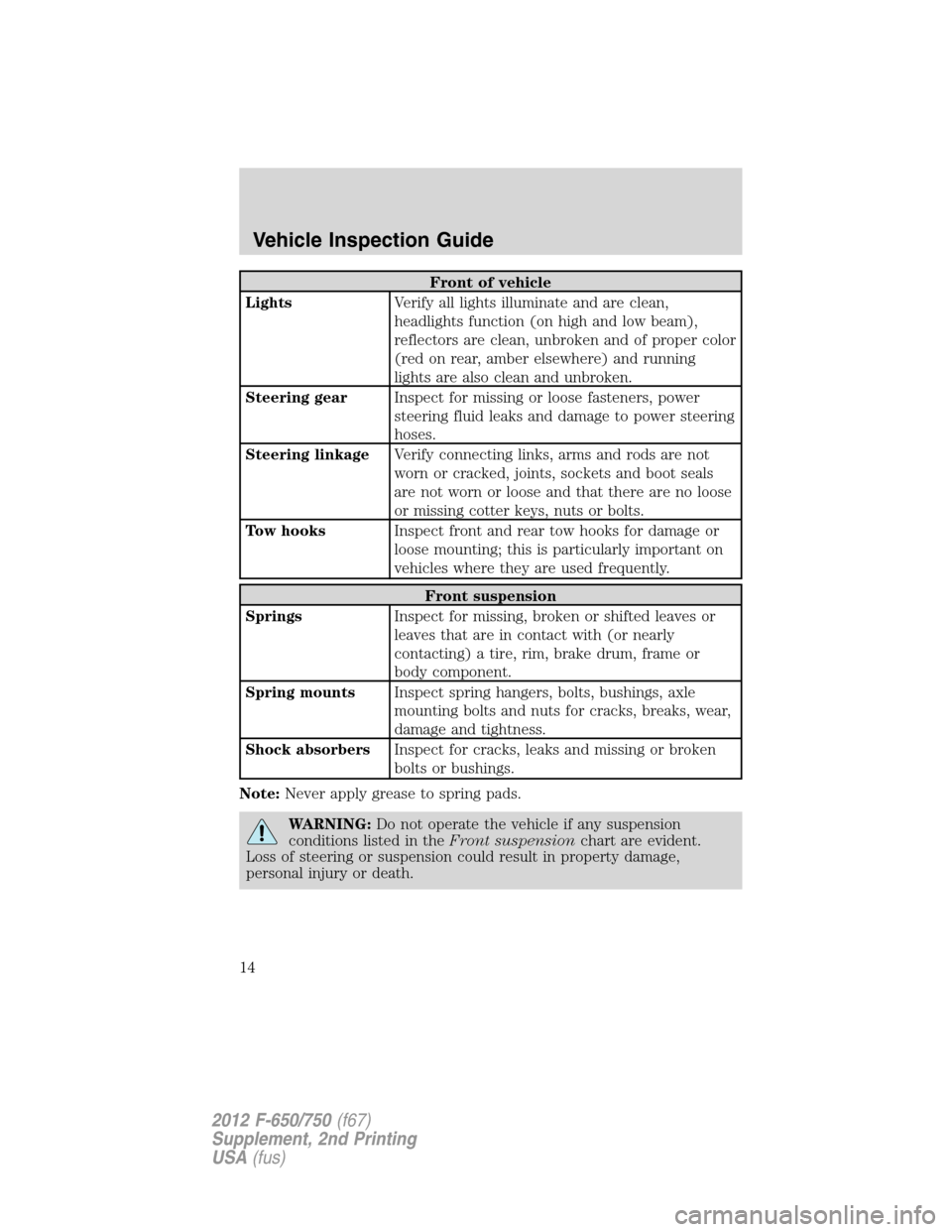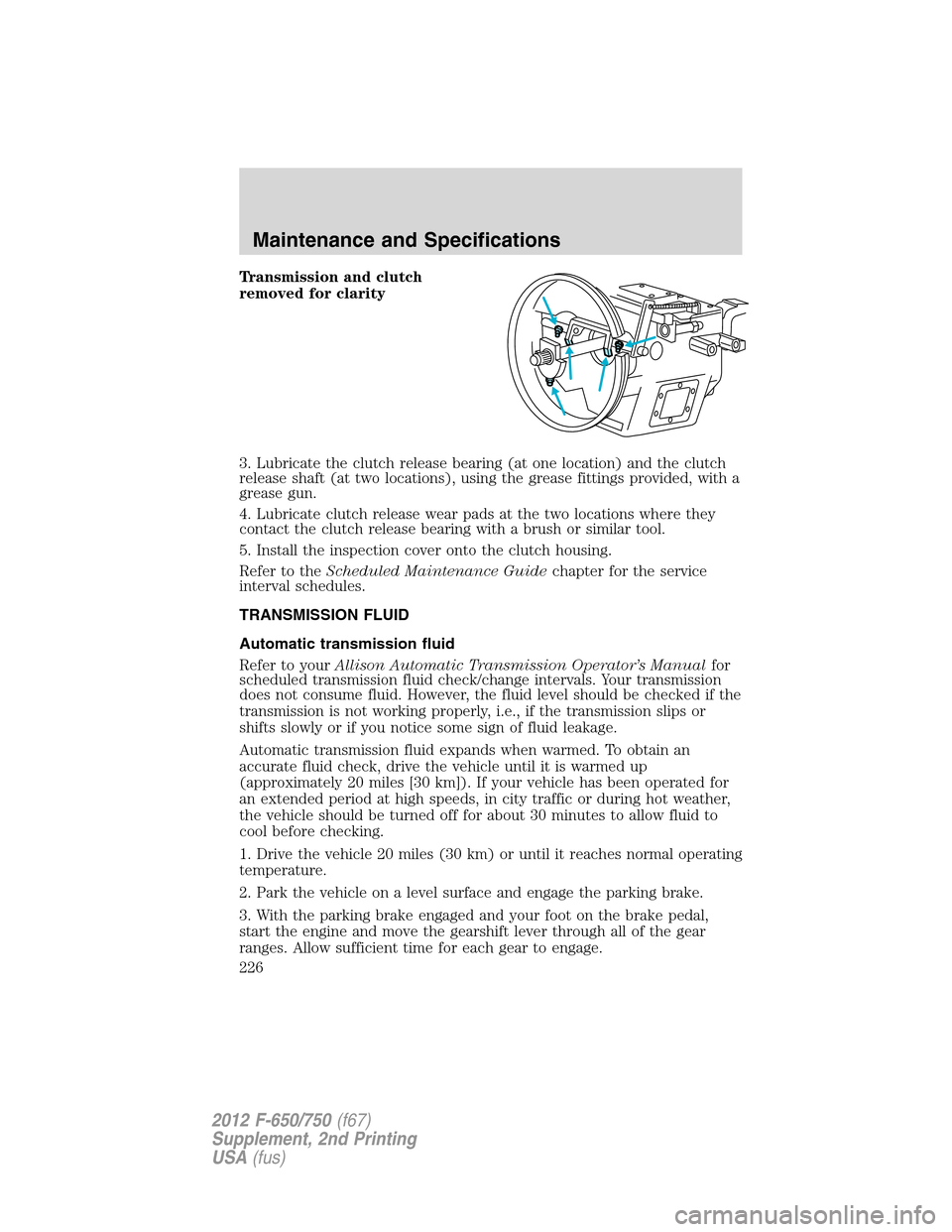brake pads FORD F750 2012 12.G Owners Manual
[x] Cancel search | Manufacturer: FORD, Model Year: 2012, Model line: F750, Model: FORD F750 2012 12.GPages: 306, PDF Size: 1.74 MB
Page 14 of 306

Front of vehicle
LightsVerify all lights illuminate and are clean,
headlights function (on high and low beam),
reflectors are clean, unbroken and of proper color
(red on rear, amber elsewhere) and running
lights are also clean and unbroken.
Steering gearInspect for missing or loose fasteners, power
steering fluid leaks and damage to power steering
hoses.
Steering linkageVerify connecting links, arms and rods are not
worn or cracked, joints, sockets and boot seals
are not worn or loose and that there are no loose
or missing cotter keys, nuts or bolts.
Tow hooksInspect front and rear tow hooks for damage or
loose mounting; this is particularly important on
vehicles where they are used frequently.
Front suspension
SpringsInspect for missing, broken or shifted leaves or
leaves that are in contact with (or nearly
contacting) a tire, rim, brake drum, frame or
body component.
Spring mountsInspect spring hangers, bolts, bushings, axle
mounting bolts and nuts for cracks, breaks, wear,
damage and tightness.
Shock absorbersInspect for cracks, leaks and missing or broken
bolts or bushings.
Note:Never apply grease to spring pads.
WARNING:Do not operate the vehicle if any suspension
conditions listed in theFront suspensionchart are evident.
Loss of steering or suspension could result in property damage,
personal injury or death.
Vehicle Inspection Guide
14
2012 F-650/750(f67)
Supplement, 2nd Printing
USA(fus)
Page 226 of 306

Transmission and clutch
removed for clarity
3. Lubricate the clutch release bearing (at one location) and the clutch
release shaft (at two locations), using the grease fittings provided, with a
grease gun.
4. Lubricate clutch release wear pads at the two locations where they
contact the clutch release bearing with a brush or similar tool.
5. Install the inspection cover onto the clutch housing.
Refer to theScheduled Maintenance Guidechapter for the service
interval schedules.
TRANSMISSION FLUID
Automatic transmission fluid
Refer to yourAllison Automatic Transmission Operator’s Manualfor
scheduled transmission fluid check/change intervals. Your transmission
does not consume fluid. However, the fluid level should be checked if the
transmission is not working properly, i.e., if the transmission slips or
shifts slowly or if you notice some sign of fluid leakage.
Automatic transmission fluid expands when warmed. To obtain an
accurate fluid check, drive the vehicle until it is warmed up
(approximately 20 miles [30 km]). If your vehicle has been operated for
an extended period at high speeds, in city traffic or during hot weather,
the vehicle should be turned off for about 30 minutes to allow fluid to
cool before checking.
1. Drive the vehicle 20 miles (30 km) or until it reaches normal operating
temperature.
2. Park the vehicle on a level surface and engage the parking brake.
3. With the parking brake engaged and your foot on the brake pedal,
start the engine and move the gearshift lever through all of the gear
ranges. Allow sufficient time for each gear to engage.
Maintenance and Specifications
226
2012 F-650/750(f67)
Supplement, 2nd Printing
USA(fus)
Page 267 of 306

Every oil change
BrakesLubricate the air brake foot control valve, hinge
and roller.
Inspect the drum brake linings through the
inspection holes.
Lubricate the rear caliper slide rails.
Lubricate the brake camshafts (air brakes only).
Lubricate the brake slack adjuster (air brakes
only).
Inspect the disc brake pads and the piston boots
(hydraulic brakes only).
ClutchLubricate the clutch release cross shaft and all
linkages.
Check the clutch fluid level.
Fuel systemDrain the accumulated water or sediment from
the fuel tank(s).
Steering systemLubricate the steering shaft(s), U-joints and
splines if equipped with grease fittings.
Lubricate the front axle spindle pins.
Lubricate the steering linkage when equipped
with grease fittings.
Lubricate the power steering gear output shaft.
* Coolant protection checks should be made just prior to the onset of
freezing weather, where applicable. If coolant is dirty or rusty in
appearance, the system should be drained, flushed and refilled with the
prescribed solution of cooling system fluid and distilled water. Use only
permanent type coolant that meets specifications as listed in your
engine operator’s manual. See the engine manufacturer’s operating
guide for supplemental corrosion inhibitor specifications.
Scheduled Maintenance Guide
267
2012 F-650/750(f67)
Supplement, 2nd Printing
USA(fus)